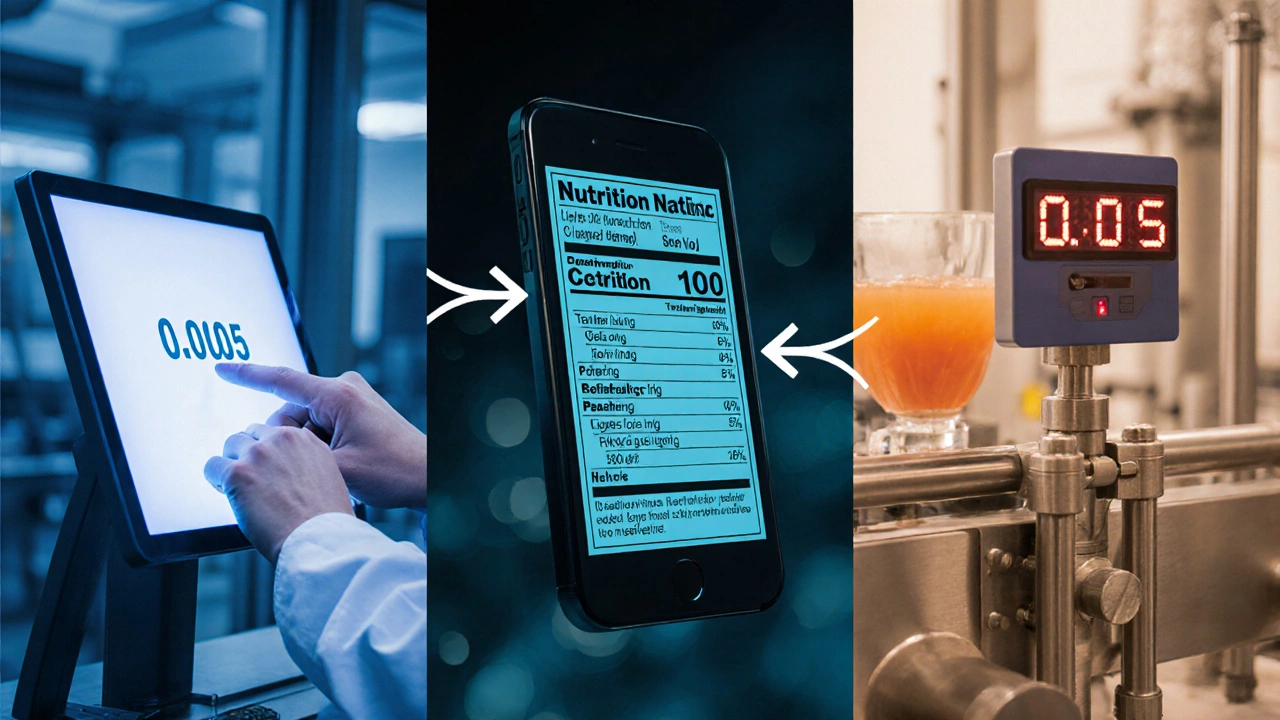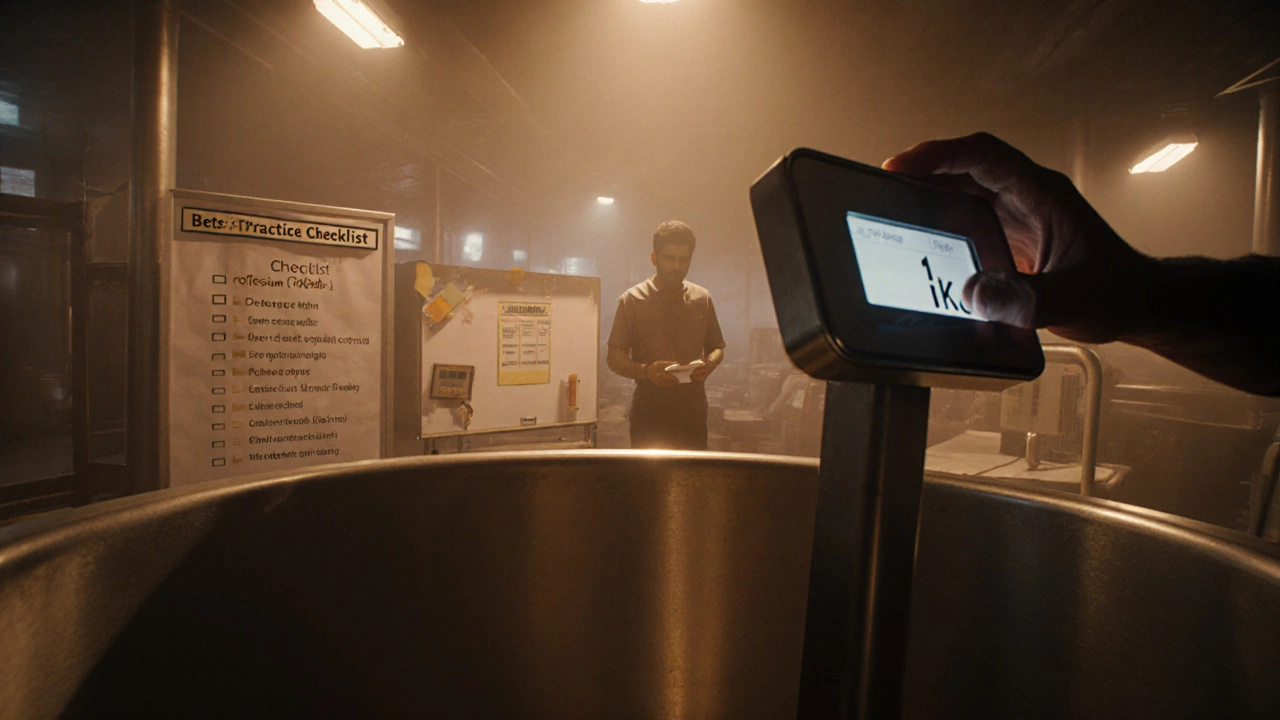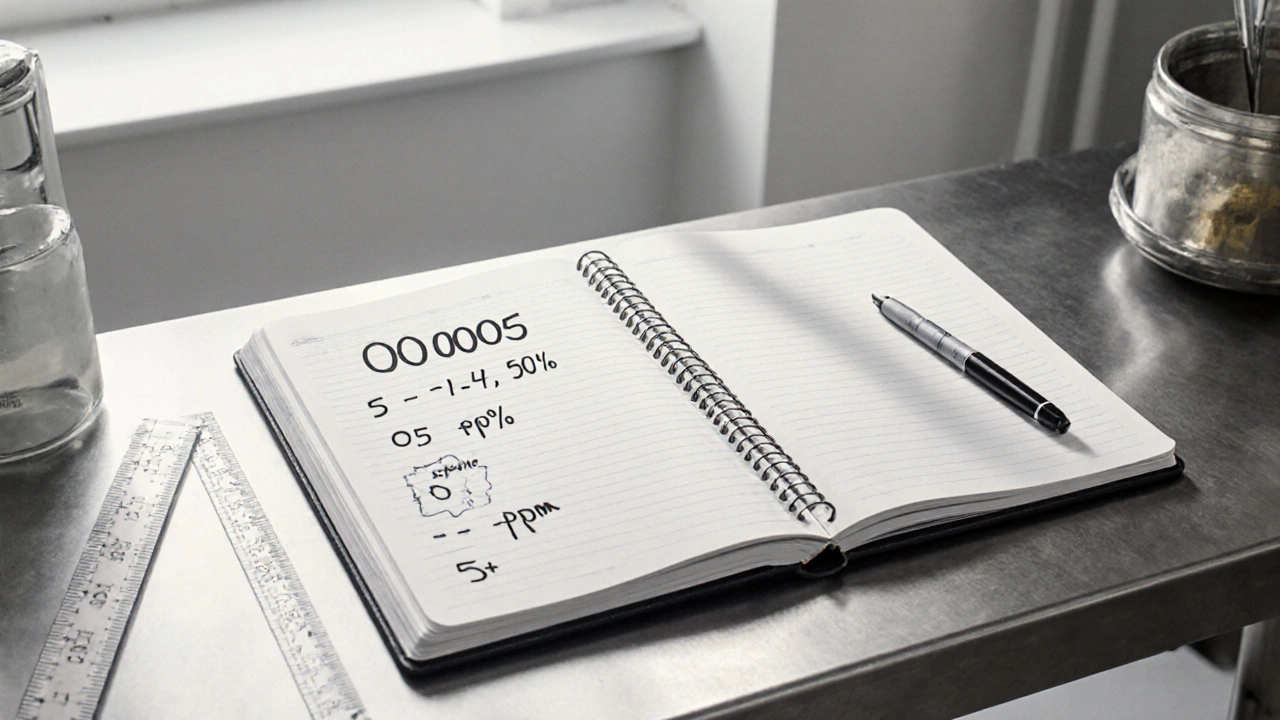Decimal-Percentage-PPM Converter for Food Processing
Unit Conversion Tool
Convert .0005 or any value between decimal, percentage, ppm, and scientific notation formats.
Batch Calculation Tool
Calculate ingredient amounts based on batch size and concentration.
For a 2,000-kg batch needing 0.0005 concentration:
0.0005 × 2,000 kg = 1 kg of ingredient
This equals 0.05% or 500 ppm of the total batch
When you see a tiny number like .0005 on a formula sheet or a label, it can feel cryptic. In food processing that figure shows up in recipes, safety limits, and quality‑control checks, but most people don’t know what to call it or how to work with it. Below we break the number down into plain‑language terms, show how to switch between decimal, fraction, percentage and parts‑per‑million (ppm), and explain why the right notation can keep a product safe, tasty, and compliant.
.0005 is a decimal value equal to five ten‑thousandths. It can also be written as 5 × 10⁻⁴, 0.05 % or 500 ppm. Each representation has its own use case in a processing plant.
Plain‑language meaning of .0005
Think of .0005 as “five tenths of a thousandth.” If you split a whole into 10,000 equal parts, five of those parts make .0005. In everyday talk you’d say it’s “five ten‑thousandths.” The same number expressed as a fraction is 5⁄10,000, which reduces to 1⁄2,000.
From decimal to percentage, ppm and scientific notation
Conversions are straightforward once you know the steps:
- Percentage: move the decimal two places to the right and add a % sign. .0005 → 0.05 %.
- Parts per million (ppm): multiply by 1,000,000. .0005 × 1,000,000 = 500 ppm.
- Scientific notation: write the number as a coefficient between 1 and 10 times a power of ten. .0005 = 5 × 10⁻⁴.
Each format tells a slightly different story. Percentages are common on nutrition labels, ppm is the language of safety limits (e.g., contaminants, preservatives), and scientific notation appears in research papers and formulation software.
Why the exact expression matters in food processing
Food manufacturers must meet strict regulations on additives, contaminants, and labeling. A mistake of even 0.0001 can shift a product from “safe” to “non‑compliant.” For instance, the U.S. Food and Drug Administration (FDA) caps sodium benzoate at 0.1 % (1,000 ppm) in most beverages. If a formula calls for 0.05 % and you record it as 0.5 % (a ten‑fold error), the batch could be pulled from the market.
Percentage a way of expressing a number as a part of 100
Parts per million a unit that denotes one part of a substance per one million parts of the total mixture
Scientific notation a compact way of writing very large or very small numbers using powers of ten

Common food‑industry scenarios that use .0005
Below are three real‑world cases where .0005 shows up and how the choice of notation influences the workflow.
- Preservative dosage: A dairy plant needs to add potassium sorbate at 0.0005 (5 × 10⁻⁴) of the total weight. The production software accepts ppm, so the operator inputs 500 ppm. The batching system calculates the exact gram amount based on the total batch size.
- Acidity control: In a fruit‑juice concentrate, the target pH adjustment corresponds to adding citric acid at 0.05 %. Lab technicians record the value as 0.05 % on the batch record, which the quality‑control (QC) team later converts to 500 ppm for the inline sensor calibration.
- Flavor strength: A flavor house measures vanillin extraction efficiency at 0.0005 % of the starting material. Because the figure is so low, it’s reported in ppm (500 ppm) on the technical data sheet, making it easier for formulators to compare with other extracts.
Step‑by‑step calculation example
Suppose you have a 2,000‑kg batch of sauce and need to add a preservative at .0005 of the total weight.
- Convert .0005 to a fraction of the batch: 0.0005 × 2,000 kg = 1 kg.
- If the plant’s scale reads in grams, convert: 1 kg = 1,000 g.
- Alternatively, work in ppm: 500 ppm × 2,000 kg = 1,000,000 g × 500 / 1,000,000 = 1 kg (same result).
- Record the dosage on the batch sheet as 0.05 % (percentage) and 500 ppm (sensor setting).
Doing the conversion twice-once in decimal, once in ppm-acts as a double‑check, reducing the risk of a ten‑fold error.
Quick reference table
| Format | Symbol / Value | Typical Use in Food Processing |
|---|---|---|
| Decimal | 0.0005 | Formulation software inputs |
| Fraction | 5⁄10,000 (or 1⁄2,000) | Quality‑control documentation |
| Percentage | 0.05 % | Nutrition labels, SOPs |
| ppm | 500 ppm | Contaminant limits, sensor calibration |
| Scientific notation | 5 × 10⁻⁴ | Research reports, R&D calculations |

Pitfalls to avoid
- Mixing units: Never enter a percentage value into a ppm field without converting first. The resulting concentration will be off by a factor of 10,000.
- Rounding too early: Rounding .0005 to .001 in a spreadsheet discards half of the intended dosage. Keep at least six decimal places until the final step.
- Label‑to‑formula mismatch: Front‑of‑package labeling often shows percentages, while internal formulas may be in ppm. Keep a conversion log for audits.
Best‑practice checklist
- Record the original number in decimal form on the batch sheet.
- Convert to the unit required by the equipment (ppm for sensors, % for labels).
- Document both the conversion factor and the final value.
- Validate the calculated mass with a secondary method (e.g., weight check).
- Store the conversion table in the standard operating procedures (SOP) library.
Frequently asked questions
What does .0005 mean in everyday language?
It’s five ten‑thousandths of a whole, which you can also call 0.05 % or 500 ppm.
Why do food manufacturers use ppm instead of percentages?
ppm provides a clear scale for very small concentrations, such as contaminants or trace additives, where a percentage would be a tiny decimal that’s easy to misread.
How can I convert .0005 to a weight for a batch?
Multiply .0005 by the total batch weight. For a 2,000 kg batch, .0005 × 2,000 kg = 1 kg of the ingredient.
Is 0.0005 the same as 0.05 %?
Yes. Move the decimal two places to the right (0.0005 → 0.05) and add a percent sign.
Can I write .0005 as 5 × 10⁻⁴?
Exactly. Scientific notation is handy for calculations in R&D reports because it shows the scale clearly.
Understanding how to read and translate .0005 removes guesswork from formulation, quality control, and compliance. Whether you’re a line operator, a QC analyst, or a product developer, keeping the right unit in front of you-and double‑checking with a second one-keeps batches safe, tasty, and on the books.










